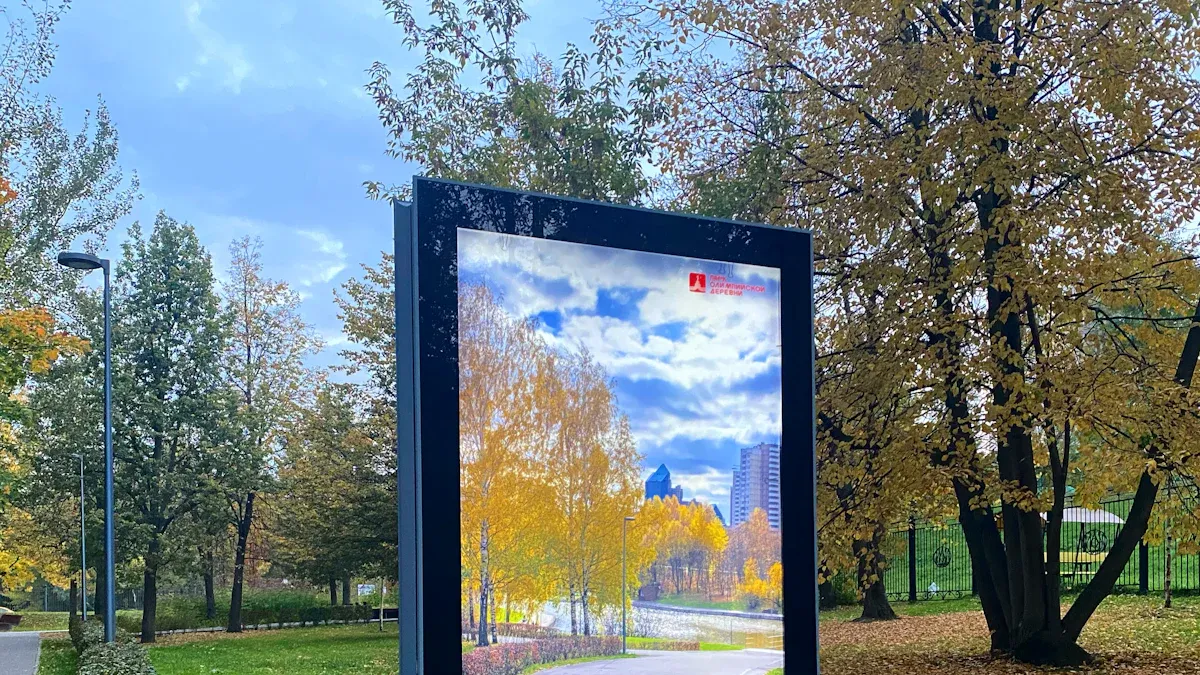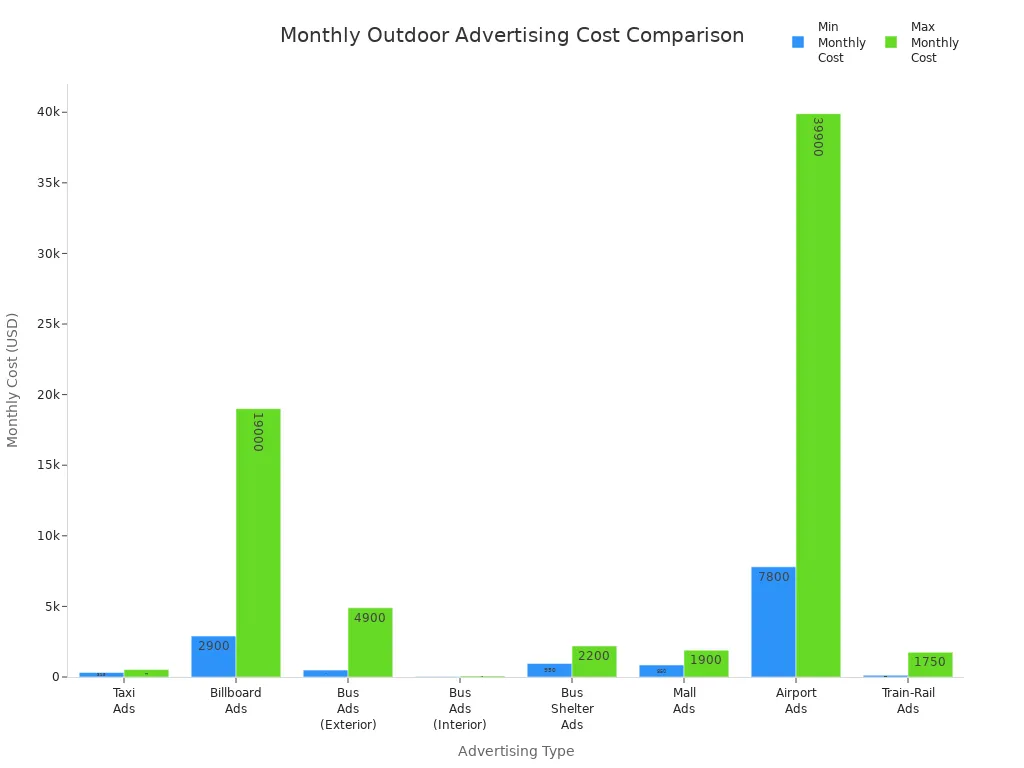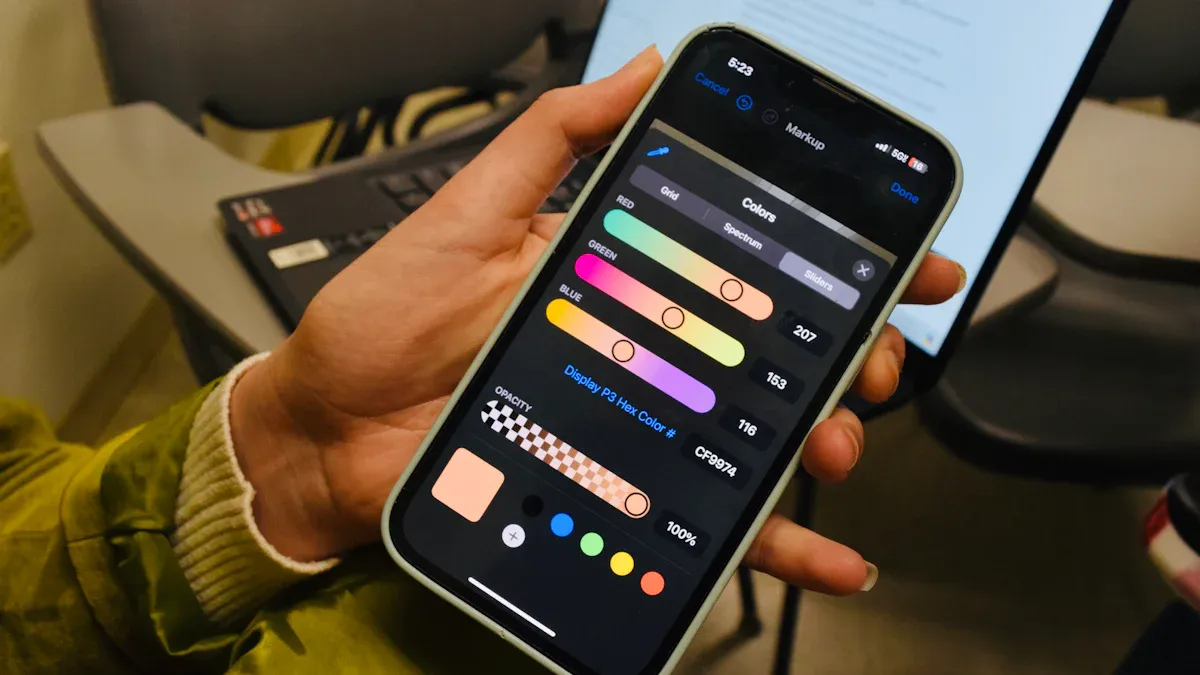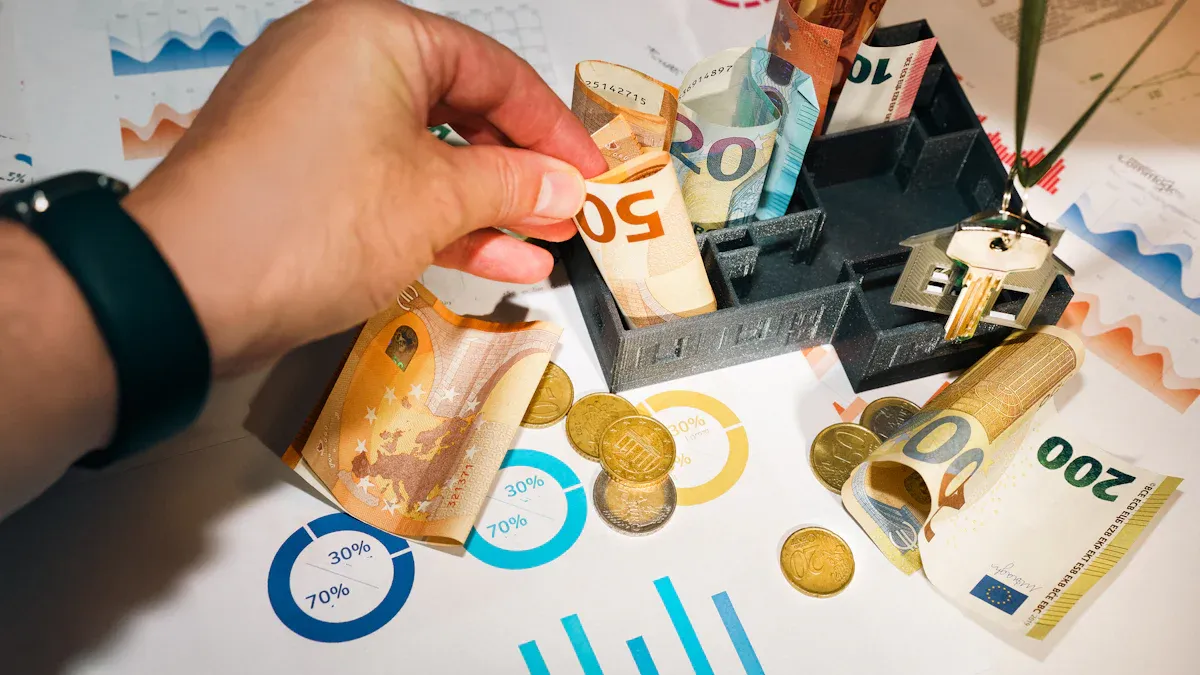
Location-based taxi ad screens offer brands excellent investment value. These screens help brands get noticed and deliver real results. In major cities like New York and London, over 60% of advertisers rely on them. Digital ad screens in taxis reach millions of people every month. Taxi ads capture 3 to 5 times more attention than traditional billboards because they display moving content and can target audiences more effectively. The global market for these ads continues to grow by over 5% annually. More businesses recognize that this type of advertising provides strong investment value by being both affordable and easy to use.
Key Takeaways
Location-based taxi ad screens reach lots of people. They get more attention than regular billboards. This makes them a smart and cheap way to advertise.
The market for taxi ad screens is growing very fast everywhere. This happens because of new technology, bigger cities, and ride-hailing services.
Modern taxi ad screens use GPS and data. They show ads that match the place and time. This helps brands reach the right people in a good way.
Taxi ad screens give a high return on investment. They cost less than many other outdoor ads. They also have flexible payment choices.
Brands can do better by using clear and bold ads. They should target busy routes and times. They can also update ads fast with real-time data.
Market Overview
Market Size
The market for location-based taxi ad screens is growing fast. In 2024, the global market size is about $1.2 billion. Experts think it will reach $3.5 billion by 2033. This shows people believe the market will keep getting bigger. The compound annual growth rate (CAGR) from 2026 to 2033 is 12.5%. Many things help this growth, like new technology, more people living in cities, and more ride-hailing services.
Year | Estimated Market Size (USD Billion) | CAGR (2026-2033) |
|---|---|---|
2024 | 1.2 | N/A |
2033 | 3.5 | 12.5% |
The global taxi ad screen market is also called the in-taxi digital signage market. It should grow from $755 million in 2024 to $1.21 billion by 2034. This happens because display technology is better and more people want smart mobility solutions.
Growth Trends
Many trends help location-based taxi ad screens grow:
More people move to cities, so there are more taxis and riders.
AI-powered advertising uses GPS and geofencing to target people.
Touchscreen and voice features let riders interact with ads.
5G helps with high-quality streaming and real-time data.
Cloud platforms make it simple to update ads and check results.
Brands spend more on digital ads to see clear results.
Payment and e-commerce features let people buy things on screens.
Smart city projects and electric taxis bring more digital upgrades.
Ride-hailing apps like Uber and Lyft give more chances for in-taxi ads.
Note: These trends show that technology and city growth help the market. Brands and taxi owners both gain from these changes. Taxi ad screens are a smart choice for the future.
Investment Value Overview
ROI Factors
Many things make taxi ad screens a good investment. North America is the biggest market. In 2024, it is worth $0.5 billion. By 2033, it may reach $1.1 billion. This means it grows by 10.3% each year. Around the world, the market could be over $6 billion by 2034. It grows about 8% every year. These numbers show there is a lot of promise for making money.
Some important things affect ROI:
AI and machine learning help ads reach the right people. This makes more people pay attention and take action.
Real-time data helps advertisers see how ads are doing. They can change their plans fast if needed.
Using electric taxis is better for the environment. This matches new rules and helps people like the ads more.
Moving into new cities and countries gives more chances to grow.
Working with taxi companies and rideshare apps helps show more ads. This makes it easier to earn money from many cars.
Advertisers can pick how they want to pay for ads. They can choose CPM, CPC, CPA, flat rates, or share revenue.
Fun and changing ads that fit the riders get more attention. This helps make more money from ads.
Where the taxi goes, how long the trip is, and how long the ad plays matter. Ads in busy places or at busy times cost more and reach more people.
Updating ads quickly and showing them to the right people helps a lot. This makes ads work better.
Note: Advertisers who use smart targeting and data tools make more money. They can also change their ads fast when the market changes.
Cost Structure
Knowing the costs is important to see if taxi ad screens are a good deal. Costs include putting in the screens, fixing them, and paying each month for ads. The table below shows common costs:
Cost Aspect | Typical Range |
|---|---|
Installation Cost | $1,000 to $20,000 (depends on many things) |
Annual Maintenance | Starts at $500 each year |
Paying for taxi ads each month is cheaper than many other outdoor ads. The next table shows how much different ads cost each month:
Advertising Type | Monthly Cost Range (4 weeks) |
|---|---|
Taxi Ads | |
Billboard Ads | $2,900 to $19,000 |
Bus Ads (Exterior) | $490 to $4,900 |
Bus Ads (Interior) | $35 to $75 |
Bus Stop Shelter Ads | $950 to $2,200 |
Mall Ads | $850 to $1,900 |
Airport Ads | $7,800 to $39,900 |
Train-Rail Ads | $125 to $1,750 |

Taxi ad screens save money, especially when compared to billboards and airport ads. Advertisers can pick from different types. Interior tablets cost about $30 per cab each month. Taxi tops cost $100 to $200. Digital taxi tops are $120 to $180. Taxi trunks are about $150. Full wraps cost about $2,000.
How long the trip is, where the taxi goes, and how long the ad runs all matter. Screens in busy areas cost more because more people see them. Ads during busy times or special events cost more and make more money. Updating ads quickly and showing them to the right people helps ads work better.
Tip: Keep screens clean and check them often. This keeps ads looking good and working well. It also protects your investment.
Technology and Targeting

Digital Screen Features
Modern taxi ad screens use new technology to get people’s attention. These digital screens have many features that make them different from old ads.
Real-time geo-targeting shows ads based on where the taxi is. This makes each ad more useful for people nearby.
Interactive displays let riders touch the screen or scan QR codes. Passengers can join in with the ads right away.
Dynamic content rotation changes ads for the time, weather, or events. This keeps ads new and interesting for everyone.
Remote updates use 4G or 5G to change ads fast. Advertisers do not need to pay extra to update the screens.
Data analytics integration checks how well ads are doing. Brands can use this to make their ads work better.
Eco-friendly design helps save paper and energy. This is good for the planet and helps with green goals.
High visibility comes from bright LED screens on taxis. These screens help ads reach lots of people in busy cities.
Cost-effectiveness is a big plus because there are no printing or setup costs.
Tip: Brands can change their ads right away. This helps them keep up with new trends or special events.
Location-Based Targeting
Location-based targeting uses GPS and smart software to show the best ad. It helps show the right ad to the right people at the right time. Taxi ad screens can show ads that fit local habits, events, or even the weather. This makes ads more useful and gets more people to notice them. Advertisers can change ads from far away using 4G, WiFi, or GPS. Screens can get brighter or dimmer so people can always see them. Playback logs help brands see how well their ads do and make better plans. By reaching people where they live, work, and travel, location-based targeting helps every ad dollar go further.
Benefits
Targeted Reach
Taxi ad screens help brands reach the right people in cities. One taxi can drive over 300 kilometers each day. It goes through business areas, homes, and busy stations. Because taxis move a lot, they can show ads to more people than billboards. Advertisers can change ads by GPS and time. For example, breakfast ads show in the morning. Nightlife ads show at night. This makes each ad fit what people want to see.
Evidence Aspect | Description |
|---|---|
Mobility and Reach | One taxi goes to many city places each day. It can reach up to three times more people than fixed ads. |
Dynamic Content | Ads change by GPS and time to match local needs and events. |
Data Tracking and Analytics | GPS and IoT sensors track how many people see and interact with ads. This helps target the right people and measure results. |
Advertisers get helpful data from these screens. GPS and IoT sensors record where and when ads play. This helps brands show ads to the right people and check how well ads work.
Engagement
Taxi ad screens make people pay attention. LED screens are bright and easy to see. People walking or riding in taxis look at these screens for over five seconds. This is longer than most other ads. People remember these ads seven times better than billboards. Some screens have QR codes. These let people connect with brands right away. Real-time data helps advertisers change ads fast. This keeps ads new and interesting.
Tip: Brands should use big, clear pictures and strong messages. This helps get noticed on busy city streets.
Brand Visibility
Taxi ad screens help more people see brands in cities. Digital taxi ads are lively and let people interact. They stand out more than still billboards. City travelers notice the bright screens. This helps them remember the brand. Seeing the ads often as taxis move helps people know the brand and want to buy.
Bright LED screens catch eyes and help people remember ads.
Ads show all day and night, so people see them a lot.
GPS and data tools help brands check how ads are doing.
QR codes and social media links let people join in.
Seeing ads many times helps people remember and take action.
Taxi ad screens turn taxis into moving billboards. They help brands reach city people in strong ways.
Revenue and Profitability

Revenue Streams
Taxi ad screen operators make money in different ways. The main way is by selling ad space to brands and agencies. Advertisers pay to show their ads on screens inside or on top of taxis. These ads reach people riding in taxis and people walking outside. This makes them a good choice for businesses.
Operators also team up with local businesses and event planners. These partnerships help both sides:
Hotels, restaurants, and event planners work with taxi operators to get more people to see their services.
Community events and local deals help brands meet people nearby and build trust.
Taxi operators get steady work by teaming up with hotels and airports, where many guests need rides.
Restaurants, bars, and fun places use these deals to bring in more customers.
Technology platforms help partners book, track, and pay for taxi rides, making things easier.
These partnerships keep taxis busy and seen in crowded places. This steady flow of riders helps ads reach more people and brings in more money.
Some operators also earn money by offering data analytics. They give advertisers reports about how well ads do, who sees them, and how people react. This extra service gives more value and adds another way to make money.
ROI
Return on investment (ROI) is very important for people thinking about taxi ad screens. Many things affect how much money they make, like ad prices, costs, and how well ads work.
A simple ROI example for a taxi ad screen is shown here:
Item | Amount (per taxi, per month) |
|---|---|
Average Ad Revenue | $450 |
Monthly Operating Costs | $150 |
Net Profit | $300 |
ROI Formula | (Net Profit / Costs) x 100 |
ROI Example | (300 / 150) x 100 = 200% |
This shows one taxi can make a 200% ROI each month. Real results depend on things like where the taxi goes, how often it drives, and how many ads are sold.
Busy routes help taxis make more money. Taxis in downtown or near airports show ads to more people. This makes each ad spot worth more and brings in more advertisers. Changing ads in real time also helps ROI. Operators use GPS and special software to change ads by place, time, or event. This makes ads fit better and gets more people interested, so advertisers get better results.
Note: Using busy routes and real-time updates gives great value to taxi operators and advertisers. This way helps make more money and helps the in-taxi digital signage market grow for a long time.
Taxi ad screens are a smart investment because they give high returns, many ways to make money, and can change fast when the market does.
Trends and Competition
Innovations
Taxi ad screens have changed a lot in the last few years. Companies now put LCD screens inside taxis. These screens let riders do more than just watch ads. Passengers can get updates, see ads for their area, and use fun features. Riders can touch the screens or scan codes. This makes the ride feel special. Brands get more people to see their ads and join in.
In Madrid, DigiTaxi started using digital screens with smart software. The system uses Artificial Intelligence and Big Data to show ads that fit each person. The screens check how people react and change ads by place and time. DigiTaxi follows privacy rules and controls what shows on screens in different vehicles. The first try in Madrid went well. DigiTaxi wants to bring these screens to more cities. These new ideas help brands find the right people and make rides better for passengers.
Note: New tech in taxi ad screens helps brands get noticed and makes rides nicer for everyone.
Competitive Landscape
Many companies want to be the best in taxi ad screens. Some of the biggest are:
Uber Technologies
Lyft
Grab Holdings
Ola Cabs
Bolt (Taxify)
Gett
Free Now
Gojek
Curb Mobility
Cabify
Other companies work on digital signs and software. These are Curb Mobility, Enroute View Media, MetroClick, Navori SA, and Samsung KNOX. North America has the most in-cabin digital signs, with over 37% of the market in 2022. Companies team up to grow faster. Verizon bought Wrapify. Lyft works with Adomni. Uber teams up with Firefly. These deals show there is a lot of competition and a race for better taxi ad tech.
Tip: Brands should keep an eye on top companies and new teams. This helps them find the best chances in this fast-moving market.
Risks and Challenges
Regulatory Issues
Taxi ad screen operators have to follow many city rules. These rules keep passengers safe and protect their privacy. Operators face some problems:
They must use screens that meet size, brightness, and color rules.
Ads must be honest, legal, and not hurt or trick people.
Operators need to keep passenger data safe with strong security.
They must check ads so nothing upsets or bothers riders.
Operators should watch how ads make people feel and change them if needed.
When operators follow these rules, passengers and city leaders trust them more.
Operational Risks
Running taxi ad screens has daily problems. Devices may stop working if not managed well. Some common issues are:
Drivers or riders might turn off the device or use it wrong.
Devices can run out of power and stop showing ads.
Drivers and riders help keep devices working, but this can cause trouble.
Devices can get lost or stolen if not locked or tracked.
It is hard to update devices from far away without good tools.
Operators use some ways to lower these risks:
They lock devices so only ad apps work.
They keep screens on and block buttons so no one turns them off.
They track device use and battery to stop problems.
Good planning and strong device control help ads run well.
Market Competition
Competition in taxi ad screens is tough in big cities. Many companies, big and small, want a piece of the market. They spend money on better screens, smart data tools, and ads that fit each person. Working with ride-hailing apps and media groups helps them reach more people and grow.
Aspect | Details |
|---|---|
Market Nature | |
Key Hardware Providers | Samsung, Apple, Verifone, Swipe Technologies, Touchmedia |
Software Leaders | Samsung, TouchMedia, 42 Gears Mobility Systems, Bona Phandle Media |
Emerging Startups | Cabby Tabby Technologies, Swipe Technologies |
Geographic Presence | TouchMedia works in 7 big Chinese cities |
Competitive Focus | Strong hardware, smart data, and ads for each person |
Strategic Moves | Teaming up with ride apps and media groups |
Companies that keep making better tech and strong teams will do best in this busy market.
Maximizing ROI
Campaign Optimization
Brands can get more from taxi ad screens by using smart ideas.
Data analytics help brands see how many people see and like the ads. This helps them change ads to work better.
Location-based targeting lets brands pick the best taxi routes and areas. This makes ads fit the people who see them.
Time-based campaigns run ads at busy times or during big events. This helps more people notice and remember the ads.
Simple, bold designs are best. Ads should use bright colors and clear pictures so people understand them fast, even when taxis move.
Picking the right ad type, like taxi tops, full wraps, or LCD screens, helps match the ad to the right people and budget.
Dynamic screens let people touch the ads and see new things right away. This makes people pay more attention and remember the brand.
Brands should count QR code scans or promo uses to see what works and make ads better.
Brands like Coca-Cola and Uber have shown these ideas help more people know their brand and see them in the market.
Cost Management
Taxi ad screen operators can save money by using tech and good planning. The table below shows main cost types and ways to handle them:
Cost Category | Description/Range |
|---|---|
Purchase Costs | $1,000–$10,000 per screen, based on size |
Rental Costs | $500–$1,500 per taxi/month, discounts for longer terms |
Installation | $200–$500 per taxi |
Content Creation | $500–$2,000 for custom ads |
Software | Monthly/annual fees for cloud management |
Operators often show many ads on one screen. This helps them make more money from each device. Cloud systems let them change ads and use GPS to target people. This lowers costs. Energy-saving screens use less power and save money. Digital tools and apps help track spending, set budgets, and find ways to save. Checking spending often helps operators change plans and keep their ad networks valuable.
Revenue Expansion
Taxi ad screen companies can make more money in new ways. Interactive LCD screens inside taxis let riders touch and see special ads. These features bring in advertisers who want to reach city riders. Operators can work with companies for employee rides or event shuttles. This gives steady money. Loyalty and referral programs help get repeat business. Fleet management and leasing cars add more ways to earn. Working with hotels, food delivery, and health services brings in extra money. Using AI for special ads, augmented reality, and voice ads opens new chances. Eco-friendly screens and green ads attract more brands and help the business grow.
Location-based taxi ad screens help brands get noticed by many people. These screens are a smart way to spend money because they reach the right audience. The market is getting bigger every year. Taxi ad screens cost less than old types of ads. Companies can show moving ads and change them fast. This helps them talk to city people in real time. Business leaders should think about what they want to achieve and try using taxi ad screens. Learning more or asking experts can help make the best plan for their needs.
FAQ
What is the average cost to advertise on a taxi ad screen?
Advertisers usually pay $200 to $500 per taxi each month. The price depends on the city, taxi route, and ad type. Digital screens with advanced features may cost more.
How do taxi ad screens target specific audiences?
Taxi ad screens use GPS and data analytics. They show ads based on location, time, and rider profiles. Brands reach the right people in the right places.
Are taxi ad screens effective for brand awareness?
Yes. Taxi ad screens move through busy areas and reach many people. Studies show these ads get three to five times more attention than static billboards.
What regulations affect taxi ad screens?
Cities set rules for screen size, brightness, and content. Operators must protect passenger privacy and follow advertising laws. Regular checks help keep screens compliant.
See Also
Budget-Friendly Portable CarPlay Solutions For BMW F10 Drivers
Best CarPlay Adapter Picks For VW Golf In 2025
Cost-Effective Portable CarPlay Choices Suitable For All Drivers
